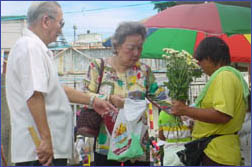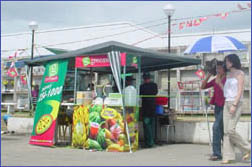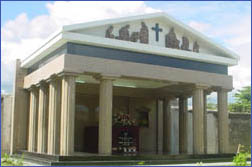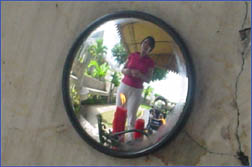Perhaps you've heard of All Saints Day and All Souls Day, aka kalag-kalag. Perhaps you've heard that, during this festival, Filipinos will spend time at the graves of their loved ones. But that's like saying that baseball is a game played with a stick and a ball.
All Saints Day is the mother of all festivals: it is a celebration, with all the feasting of a wedding or a birthday; it is a picnic, for the celebration takes place out of doors and in a grassy park; it is a religious ritual, involving prayers, candles, and incense; it is a personal spiritual event, where memories are relived and flowers offered as a sign of love and devotion; it is a reunion, of the extended family clan; and it is a party, which may involve drinking and singing and go on late into the night. The festival of All Saints Day and All Souls Day, more than any other event, brings out the unique characteristics of the Filipino spirit and amplifies the structural relief lines which define Filipino society.
Technically, November 1st is All Saints Day, a day for commemorating the lives of the numerous illustrious figures in the Catholic pantheon of saints, while November 2 is All Souls Day, a day of rememberance for the dead in one's family and community. Technically, therefore, one would go to churches and shrines on November 1, and proceed to the graveyard on November 2. However, over the years a completely different custom has evolved, which is as follows: the saints are completely ignored, and people descend to the graves of their relatives en masse on November 1, and if for some reason this was not possible, the graves are visited on November 2.
Often, people will be busy trekking from one grave to another, trying to squeeze in face time with as many souls as possible. For instance, someone may have her in-laws interred in Cebu City, and she will spend time there with her husband and family on November 1. Then, on November 2, she may drag her family to a far-off province, to be with her own deceased relatives in her hometown. Servants are often required to make themselves useful during the celebrations on November 1, and may only be given the day off on November 2. Usually, household staff hail from the outerlying provinces of Cebu island, or from other islands, and may spend the bulk of their day off in transit.
No surprise then, that ships, aircraft and buses are packed with record numbers of passengers immediately prior to and during the holiday. All Saints Day is the one day in the calendar when traveling by jeepney is inconvenient, for most jeepney drivers have cemeteries of their own to go to, and people may be stuck by the roadside for hours trying to flag a ride.
The authorities - presumably the Catholic Church included - have adapted to the reality that graves of relatives are visited on All Saints Day, and in consideration of the national government's economic situation, in 2004 All Souls Day was in fact declared a school day. But a large number of businesses remained closed out of habit, and I'd venture a bet that school attendance was at a record low.
On November 1, relatives gear up for spending time at the graveside by preparing food. A visit to the grave is not complete without a feast, modest or sumptuous as the budget will permit. The wealthier members of society will have ordered a lechon (a whole roasted pig) in advance, and some may even have arranged for a catering firm to deliver a banquet and a few waiters. But even the less well-off will bring at least a few sticks of barbecued chicken and a handful of puso. The meals are eaten at the graveside, and the lechon is often placed onto the sarcophagus itself.
Then there is the matter of flowers. Again, the wealthier Filipinos - in particular the wealthier Filipino-Chinese - will splurge on delicately
 assembled bouquets of exotic flowers, each blossom perfect and fresh from the hothouse. Yet those who aren't rich will not arrive empty-handed, bearing either less expensive cut flowers from the mountain barangay of Busay, or even just a bunch of flowers picked from the roadside.
assembled bouquets of exotic flowers, each blossom perfect and fresh from the hothouse. Yet those who aren't rich will not arrive empty-handed, bearing either less expensive cut flowers from the mountain barangay of Busay, or even just a bunch of flowers picked from the roadside.
While often the flowers will have been procured in advance, countless flower vendors will have set up shop near the entrances of the cemeteries, both outside and within the premises of the cemetery. Competing for space with the flower vendors are the candle vendors. Tons and tons of candles will have been burnt by the time the festival is over, and most of the candles are bought from vendors, who are often children.
In addition to flower and candle vendors, row upon row of stalls will have sprung up outside and within the cemeteries selling all manner of items - All Saints Day balloons, cotton candy, toys, jewelry, snacks, bottled water, cigarettes, barbecue, fastfood, and pizzas. If the pathways are wide enough, fastfood concessionaires will have, incredibly, erected stands within the grounds of the cemetery. At the Queen
 City cemetery, Kenny Rogers Roasters, Greenwich Pizza, Dunkin Donuts and Kentucky Fried Chicken were competing for customers on All Saints Day in 2004. Itinerant vendors ply the paths within the cemeteries hawking bottled water, ice cream, and peanuts, peanuts, peanuts. For some reason, peanuts - raw, boiled or roasted - are a Cebuano favorite on All Saints Day.
City cemetery, Kenny Rogers Roasters, Greenwich Pizza, Dunkin Donuts and Kentucky Fried Chicken were competing for customers on All Saints Day in 2004. Itinerant vendors ply the paths within the cemeteries hawking bottled water, ice cream, and peanuts, peanuts, peanuts. For some reason, peanuts - raw, boiled or roasted - are a Cebuano favorite on All Saints Day.
There are four categories of graves. The simplest is a tombstone laid on the ground. Those who can afford it avoid this type of tombstone, for after a few years it is usually broken by plant roots, and, even if it manages to stay intact, trampled on by passersby. The next best alternative is an apartment-style stacked tomb; these are usually stacked four high but may go up as eight, in the cases of children's graves. I've heard that, in the smaller church cemeteries, relatives are required to exhume and transfer their relatives to this type of stacked grave after a certain number of years due to space limitations, or else the bones end up in a collective pit, but the casket may also be interred directly into a stacked tomb. Better but more expensive than a stacked, apartment-style tomb is a stand-alone sarcophagus, on a plot owned by the family. Usually a tent is erected during the holidays over this kind of grave, to provide temporary protection from the sun and the rain. At the top end is a mausoleum, which - in extreme cases - may be two stories high and include rooms, bathrooms, and a lighting system for the comfort of the surviving family members.
Some cemeteries are exclusively for the wealthy; other cemeteries are distinctly low-rent, and some include a mix of both. There are about five major cemeteries in Metro Cebu. Queen City is a large cemetery which caters to both the less well-off and the wealthier segments of society. Next door is Ludo Memorial Park, established decades ago by a Filipino-Chinese philanthrophist. Numerous Chinese mausolea are found here in addition to the
 less expensive stacked graves. Across town is the large and somewhat downmarket Calamba cemetery. Most of the dead here are stacked four rows high, as is the case in most public cemeteries. The Mandaue Public Cemetery is huge, and houses both fairly elaborate mausolea as well as simple tombstones. Perhaps the most upmarket cemetery is Cebu Memorial Park, usually called Cempark. While Cempark does have an open area with simple stelae, it lacks the stacked tombs characteristic of the public cemeteries. The seriously rich have built amazingly ornate mausolea here, and strolling through Cempark one is reminded of the fact that the world's grandest building, the Taj Mahal, is a mausoleum erected by a loving husband for his deceased wife.
less expensive stacked graves. Across town is the large and somewhat downmarket Calamba cemetery. Most of the dead here are stacked four rows high, as is the case in most public cemeteries. The Mandaue Public Cemetery is huge, and houses both fairly elaborate mausolea as well as simple tombstones. Perhaps the most upmarket cemetery is Cebu Memorial Park, usually called Cempark. While Cempark does have an open area with simple stelae, it lacks the stacked tombs characteristic of the public cemeteries. The seriously rich have built amazingly ornate mausolea here, and strolling through Cempark one is reminded of the fact that the world's grandest building, the Taj Mahal, is a mausoleum erected by a loving husband for his deceased wife.
In recent years, developers have been muscling into the graveyard act, and some of the newer memorial parks include Golden Haven, located in the northern hills of Cebu, and Angelicum, in Mandaue. Regrettably, the corporations behind these memorial parks tend to engage in crass marketing tactics, such as hard-sell ads featuring discounts and chances to win automobiles. However, their market share is still minor, and most All Saints Day activity takes place in the long-established cemeteries.
An important element of the yearly pilgrimage to the cemetery is the act of renovating the graves. Once again, the Cebuano genius for outsourcing is apparent. Upon arrival at most cemeteries (the exception being the posh Cempark) one will be continually accosted by paint-flecked young men and children offering to clean up one's tombstone. Most of these will be carrying the necessary tools: a can of white paint, sandpaper, and a razor. The grave cleaners will meticulously touch up even the smallest tombstone in preparation for the day's celebration. The job of sprucing up a tomb is not to be underestimated. In the case of the grander mausolea, an army of servants may spend a whole day sweeping, scrubbing, polishing, and repainting before the tomb is ready for the party.
The flip side of all this industrious activity is that, if there are no relatives to look after it, a grave quickly falls into decay. It may become a dumping ground for refuse from surrounding graves, and desperate drug addicts may steal the coffin and sell it as scrap metal. At Ludo Memorial Park, squatters have taken over mausolea forfeited by the descendants of the deceased. In one instance, I was puzzled by an insistent chirping noise which, upon careful inspection, revealed itself to emanate from chicks kept inside a chicken coop erected within a Chinese mausoleum now serving as a residence for a family of squatters.
The more religious members of society will first head to the cemetery's chapel to offer candles and say a prayer, or wait to catch the Mass, before proceeding to their family's grave. Crowd control may be a problem at some of the public cemeteries. At the chapel of the Mandaue Public Cemetery, a rope prevented the faithful from pushing onto the flames, while, within the perimeter, a security guard accepted a continuous stream of candles and placed them onto the burning grills on behalf of the faithful. Outside the rope, the people prayed silently, with or without the aid of prayer sheets.
While the Filipino-Chinese join in on the celebration on November 1, they have rituals of their own. Those who lost a relative within the past year wear white, as is the case for funerals. In Filipino-Chinese families, the mausoleum or plot is purchased by the head of the clan, and in some cases most of the slots will be empty. These are marked with the Chinese character for celebration or luck, and, needless to say, are not offered any candles or flowers. While most Filipino-Chinese are Catholic,
 some observe Buddhist rituals, offering fruit to their deceased relatives in addition to flowers, and burning papers which signify money to be spent by the deceased in the afterlife. Irrespective of religion, all Filipino-Chinese offer prayers and incense after ritually bowing thrice in the Taoist manner. A mirror may be attached to the sarcophagus for reasons of superstition, or feng shui.
some observe Buddhist rituals, offering fruit to their deceased relatives in addition to flowers, and burning papers which signify money to be spent by the deceased in the afterlife. Irrespective of religion, all Filipino-Chinese offer prayers and incense after ritually bowing thrice in the Taoist manner. A mirror may be attached to the sarcophagus for reasons of superstition, or feng shui.
The essence of All Saints Day is to spend time with deceased family members, and while visits are paid to the graves of uncles and cousins, the bulk of one's time is usually spent at the grave of the immediate ancestors, such as parents or grandparents. Surviving family members may stay as long as a day, and in some cases even sleep by the grave, remaining in the cemetery overnight. While some time may be spent in prayer and silent rememberance, what really matters is to share one's time and presence. During All Saints Day, good times are created as much as they are remembered. Family members may quietly chat, snack, or play cards. On one occasion, I witnessed a group, presumably with a nerd in the family, watching a concert on a laptop which, together with the speakers, had been erected on top of the sarcophagus.
On a hot day, it is after dusk that people really start to arrive in droves. At 8 PM, a thousand candles dotted the landscape of Cebu Memorial Park as visitor density peaked for the day. Almost every grave was surrounded by relatives, snacking on peanuts, playing cards, or just relaxing and chatting. The hum of hushed voices, the gentle notes from from the occasional guitar, and the sea of candlelight combine to create a magical ambience, and I wouldn't have been surprised to see an ancestor or two sitting cross-legged amidst his children and grandchildren.
It is often mentioned that Filipinos play cards and drink while at the cemetery, and some foreigners derive the mistaken impression that raucous behavior takes place. This is definitely not the case. People do not get rowdy, out of consideration to the deceased as much to those in the neighboring plot. The respect for the dead is there, but sadness is not. A day spent at the cemetery on All Saints Day will nullify any visitor's ingrained notion that the graveyard is a ghoulish and scary place.


